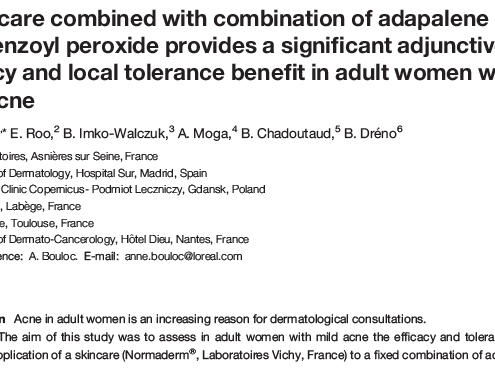
A skincare combined with combination of adapalene and benzoyl peroxide provides a significant adjunctive efficacy and local tolerance benefit in adult women with mild acne
CosmetiqueAcne in adult women is an increasing reason for dermatological consultations.
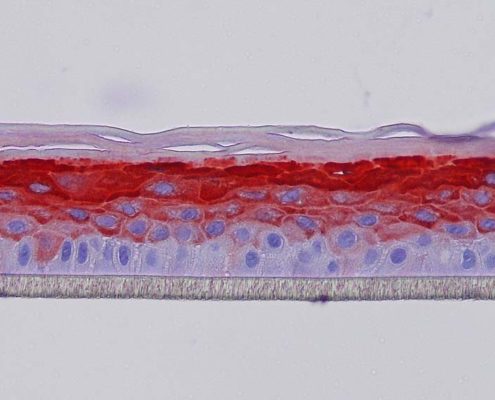
New biological effects of Aphloïol
Barrière cutanée et hydratation, Cosmétique, Cosmetique, Skin barrier and hydrationIn the present study, we identified new properties of Aphloïol (syn. mangiferin) in improving skin barrier function, especially by promoting keratinocyte differentiation, synthesis of transmembrane glycoprotein and lipid neosynthesis.
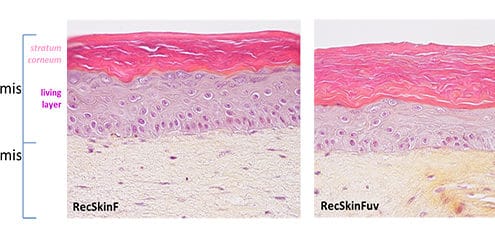
in vitro modeling of skin photoaging: development of evaluation tools for cosmetics
Cosmetique, Skin ageing, Vieillissement cutanéDevelopment of in vitro models skin for better understand the modifications during photo-aging induced by repetitive UV exposure.

in vitro modeling of skin photoaging: development of evaluation tools for cosmetics
CosmetiqueDevelopment of in vitro models skin for better understand the modifications during photo-aging induced by repetitive UV exposure.
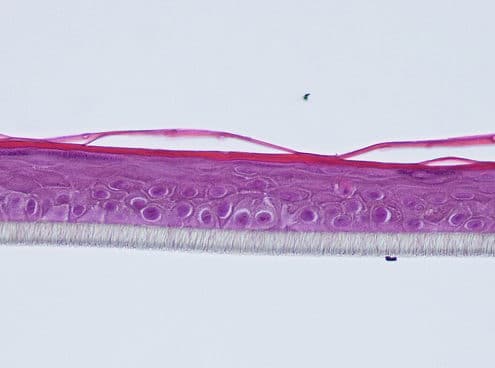
Development of a new model of reconstructed aged skin useful to study antiageing effects of cosmetic compounds
Cell and tissue engineering, Ingénierie cellulaire et tissulaire, Skin ageing, Vieillissement cutanéThe development of new anti-ageing products needs performant in vitro models mimicking morphological changes and physiological modifications appearing during skin ageing. In order to have access to a simple model mimicking the epidermis ageing but in relation with a normal dermis, we have developed a new in vitro model of reconstructed skin comprising an aged epidermis covering a reconstructed dermis built with collagen and normal (young) fibroblasts.
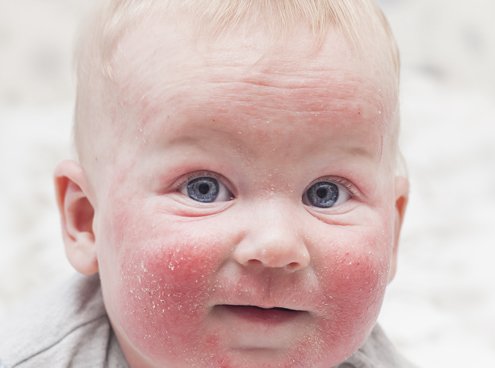
Atopic dermatitis: physio-pathology and clinical signs
CosmetiqueAtopic dermatitis is the most common dermatosis affecting children: 65% of the patients are less than a year old and 85% are below 5 years. The prevalence of this pathology is constantly on the rise and currently affects 10 to 25% of the population.
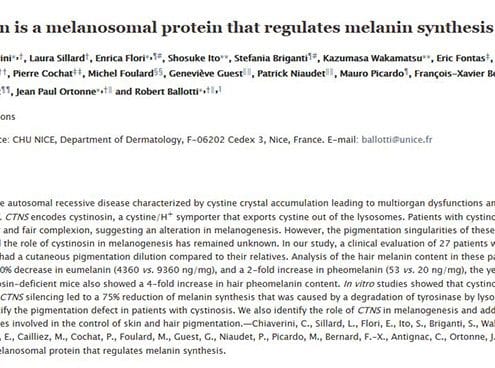
Cystinosin is a melanosomal protein that regulates melanin synthesis
Pigmentation, PigmentationIn vitro studies showed that cystinosin was located at melanosomes. CTNS silencing led to a 75% reduction of melanin synthesis that was caused by a degradation of tyrosinase by lysosomal proteases. Our results objectify the pigmentation defect in patients with cystinosis. We also identify the role of CTNS in melanogenesis and add a new gene to the list of the genes involved in the control of skin and hair pigmentation.
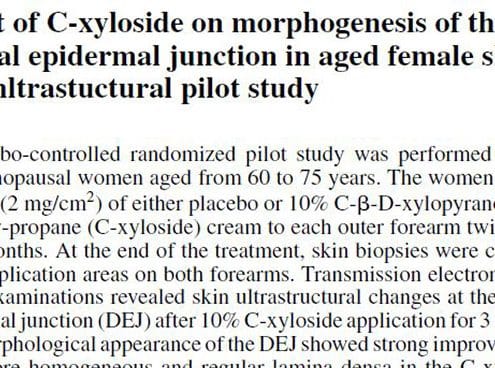
Effect of C-xyloside on morphogenesis of the dermal epidermal junction in aged female skin. An ultrastuctural pilot study
Cosmétique, Cosmetique, Skin ageing, Vieillissement cutanéThese data suggest that topical C-xyloside application in vivo may be efficient in inducing a better dermal-epidermal cohesion when such a junction is deficient, as is the case in photo-aged or chronologically aged skin. Moreover, a statistically significant increase in CD44 expression was noted in the epidermis of C-xyloside-treated compared to the placebo treated skin areas.
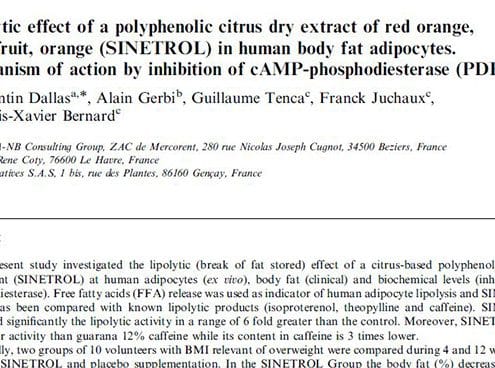
Lipolytic effect of a polyphenolic citrus dry extract of red orange, grapefruit, orange (Sinetrol) in human body fat adipocytes. Mechanism of action by inhibition of cAMP-Phosphodiesterase (PDE)
Cosmétique, CosmetiqueThe present study investigated the lipolytic (break of fat stored) effect of a citrus-based polyphenolic dietary supplement (SINETROL) at human adipocytes (ex vivo), body fat (clinical) and biochemical levels (inhibition of phosphodiesterase).
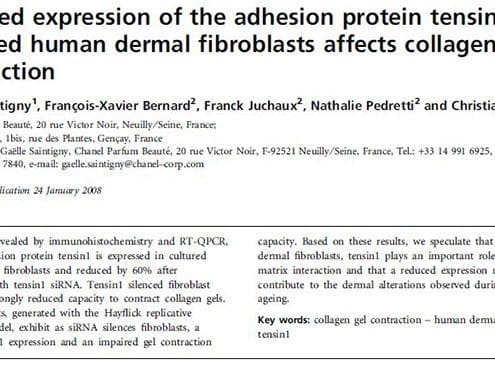
Reduced expression of the adhesion protein tensin1 in cultured human dermal fibroblasts affects collagen gel contraction
Cosmétique, Cosmetique, Skin ageing, Vieillissement cutanétensin1 plays an important role in cell-matrix interaction and that a reduced expression might contribute to the dermal alterations observed during skin ageing
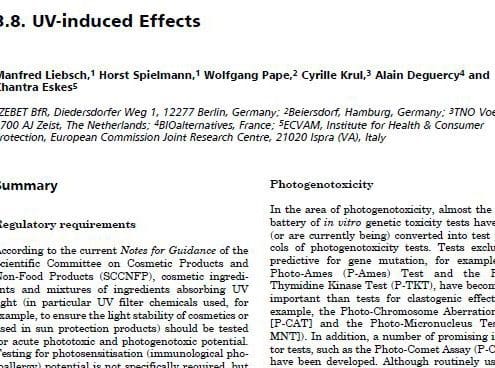
Alternative (non-animal) methods for cosmetic testing: current status and future prospects – UV-induced effects
Cosmetique, Cosmétique, Protection et défenses cutanées, Safety and toleranceCosmetic ingredients and mixtures of ingredients absorbing UV light (in particular UV filter chemicals used, for example, to ensure the light stability of cosmetics or used in sun protection products) should be tested for acute phototoxic and photogenotoxic potential.
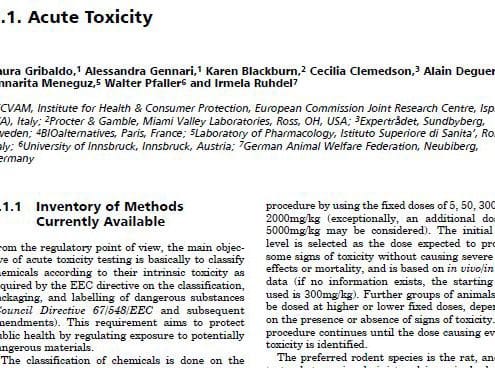
Alternative (non-animal) methods for cosmetic testing: current status and future prospects – Acute toxicity
Cosmétique, Cosmetique, Protection et défenses cutanées, Safety and toleranceFrom the regulatory point of view, the main objective of acute toxicity testing is basically to classify chemicals according to their intrinsic toxicity
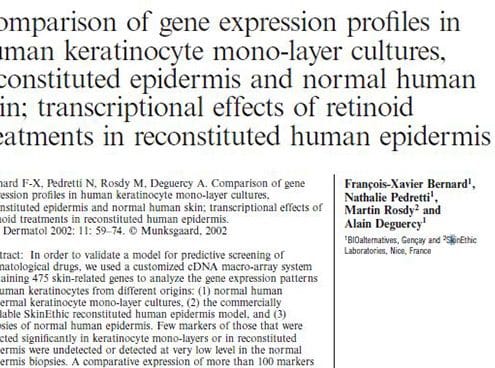
Comparison of gene expression profiles in human keratinocyte mono-layer cultures, reconstituted epidermis and normal human skin; transcriptional effects of retinoid treatments in reconstituted human epidermis
Cosmetique, Cosmétique, Epidermal regeneration, Régénération épidermiqueIn order to validate a model for predictive screening of dermatological drugs, we used a customized cDNA macro-array system containing 475 skin-related genes to analyze the gene expression patterns in human keratinocytes from different origins.
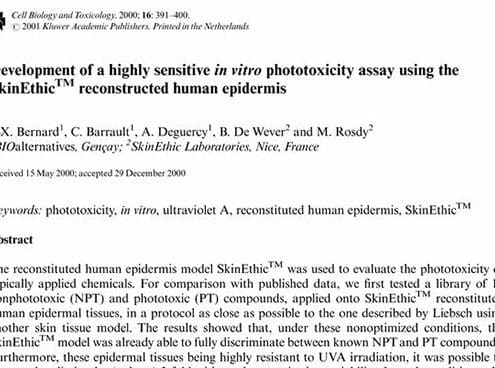
Development of a highly sensitive in vitro phototoxicity assay using the SkinEthic reconstructed human epidermis
Protection et défenses cutanées, Safety and toleranceThe reconstituted human epidermis model SkinEthic was used to evaluate the phototoxicity of topically applied chemicals.


